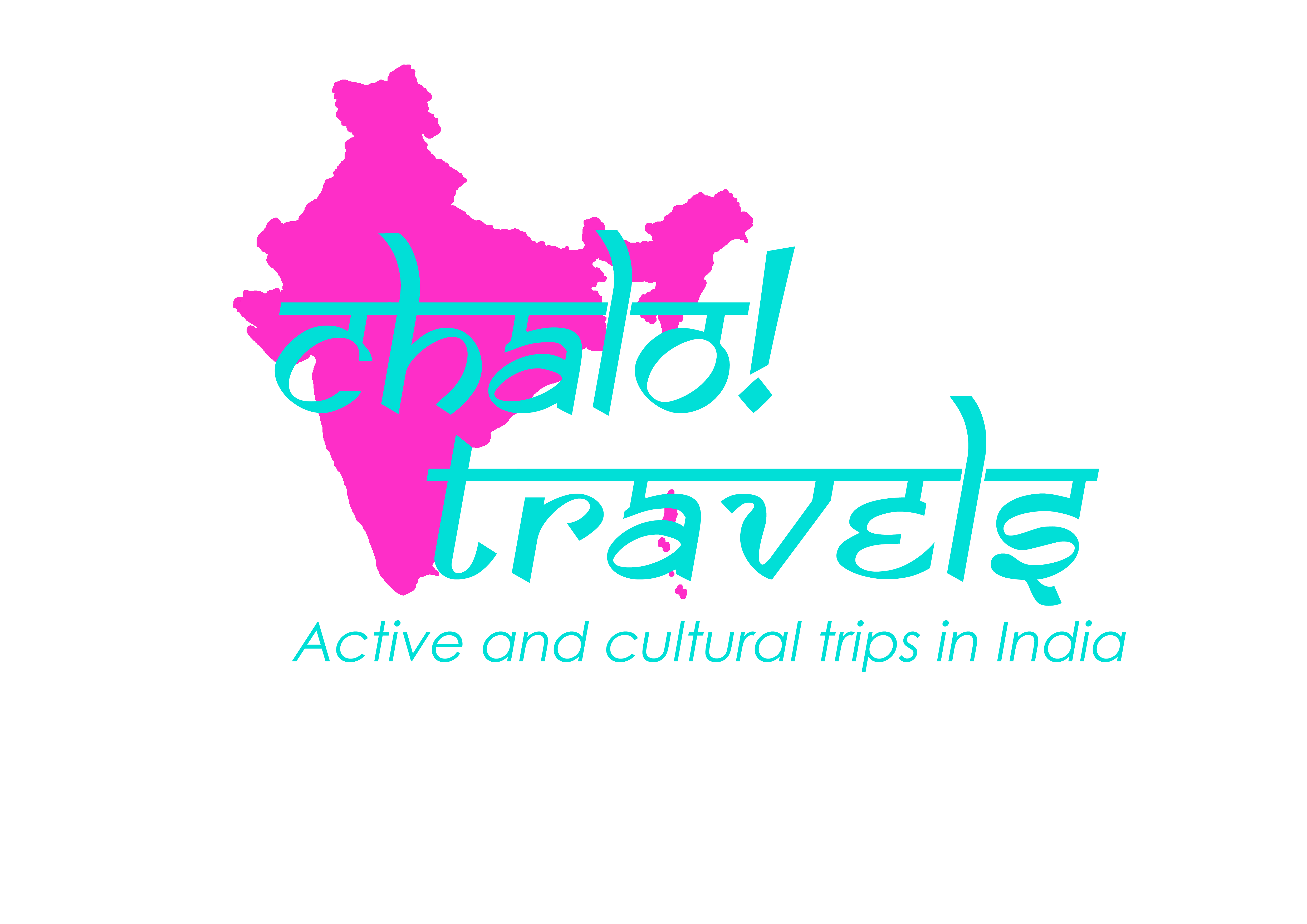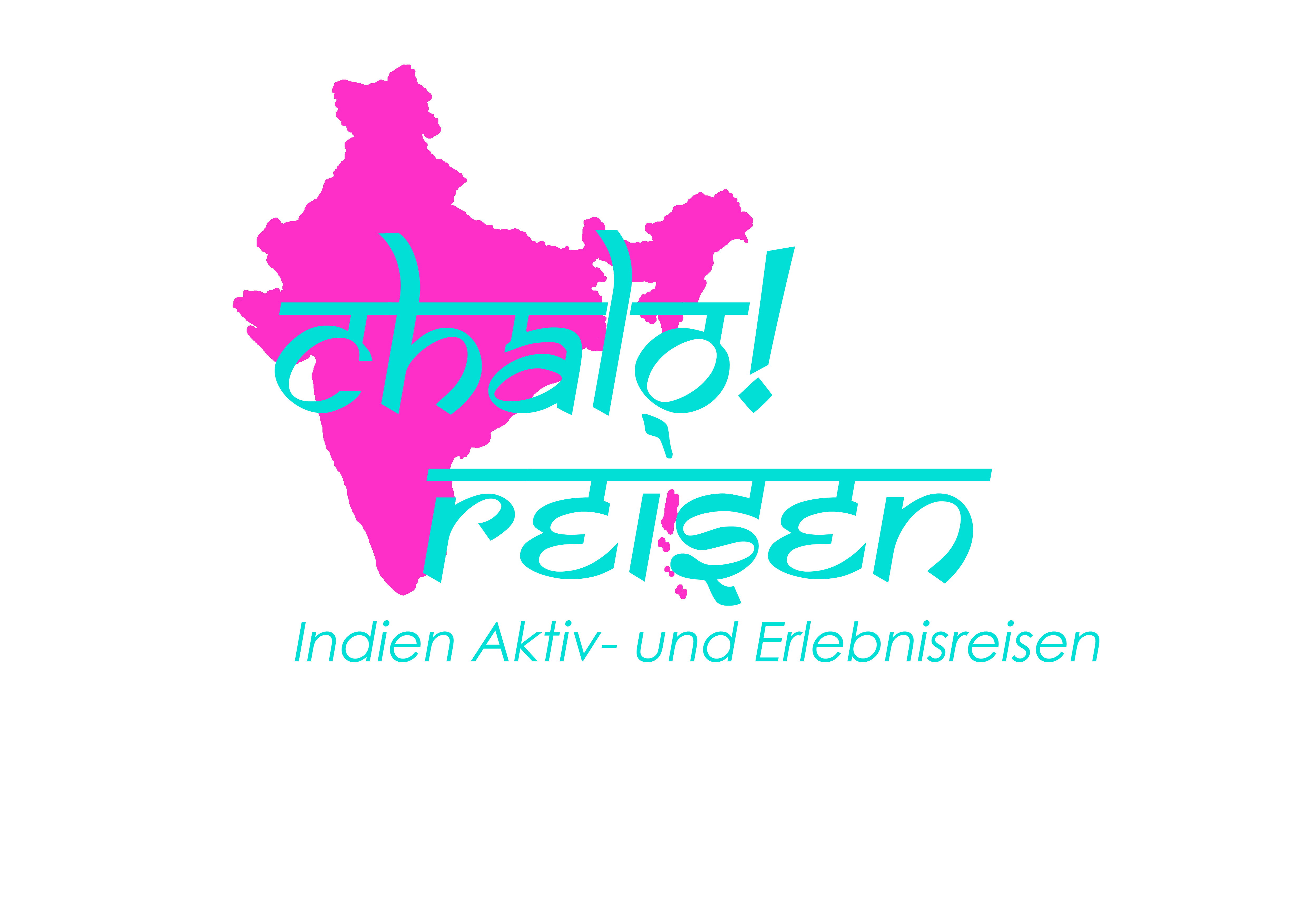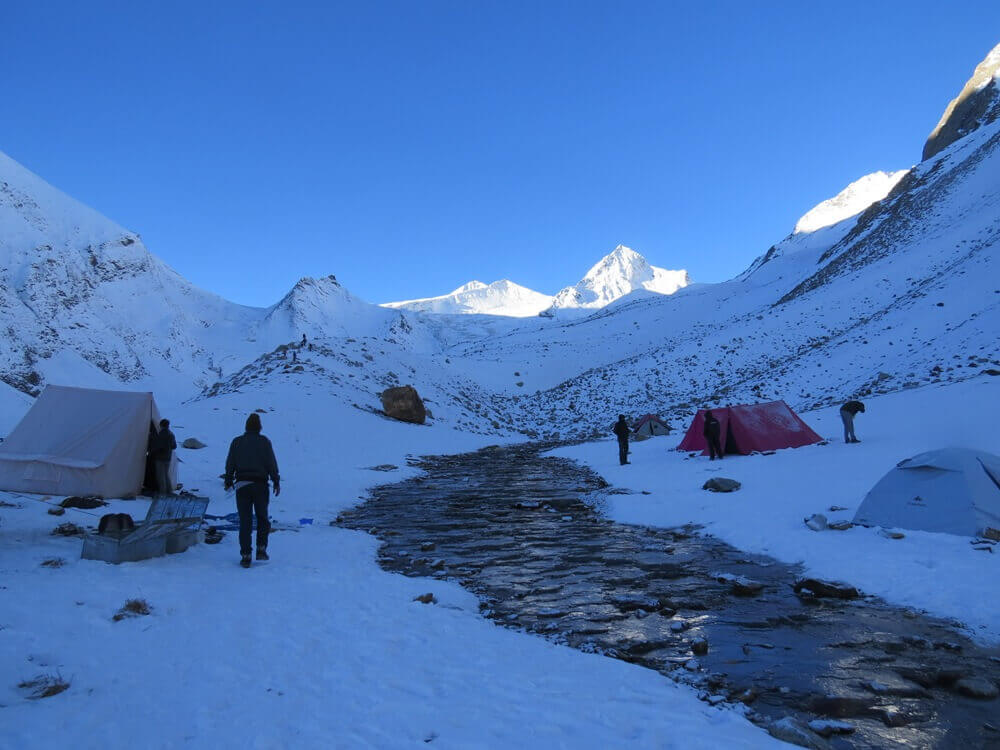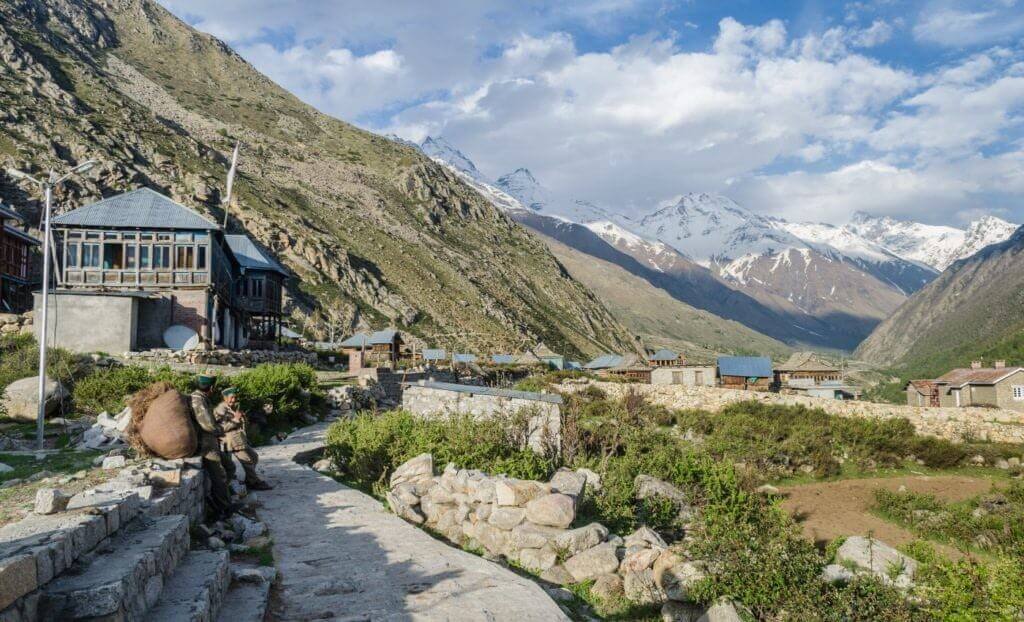- Sport & Abenteuer Reisen
- Trekking Reisen
Overview
Lamkhaga pass trek is a 90 km long trail, passing through the remotest valleys of Kinnaur (lower and upper Baspa) and Garhwal. The 5300 meters high altitude pass is a classic Himalayan crossover — between Chitkul and Gangotri.
Many days during this trek we will spend on snow and glacier.
The Pass curtails a 480 km road distance between Chitkul village of Kinnaur & Harsil village of Gangotri valley to just about 90 km.
It is a fairly remote trek and is now regarded as the classic route from Kinnaur to Gangotri, which was first crossed by Marco Pallis in 1933.
The beautiful route takes you through some of the most remote areas of Uttarakhand and Himachal Pradesh, like the Jalandhari valley that is covered with flowers post-monsoon. The snow in the early season could impede your progress. Harsil is famous for Wilson’s Cottage built in 1864. Gangotri is a short drive from Harsil, while Chitkul is the last village in the Baspa valley. Though the difficulty is a relative term, the Lamkhaga pass trek is considered the most difficult in Kinnaur-Garhwal Himalayas. Lamkhaga pass trek offers a diverse landscape that includes Ranikanda meadows, boulder-strewn terrain, Baspa glacier zone, Baspa Glacier Snout and Meadows, and small glacial lakes of Kyarkoti in Harsil valley.
Program
Day 1 Departure from home and arrival in Delhi, India
Pick-up service from the airport to our hotel (overnight stay in the hotel, air-conditioned).
Day 2 Train Ride to Shimla
In the morning we take first a train to Kalpa, near Chandigarh (4 Hours) and change then into the famous Kalpa Shimla Toytrain. The 96 kilometer (4-5 hours) narrow-gauge Kalka-Shimla Railway was opened in 1903 to connect Shimla, the summer capital of British India, with the northern plains. Itleads through 103 tunnels and over 864 bridges all the way up from an altitude of 655 m to 2080 m. A real highlight of the trip. In teh afternoon we check in in our heritage hotel Woodville Palace and will enjoy an dinner at the famous Shimla Mall at the Ridge. Overnight stay at Hotel (B/-/D)
Day 3 Drive to Chitkul, 250 km, 10 km drive
Our journey continuous in the car. A whole day drive takes as deeper and deeper into the Himalaya along the Satluj River all the way to the mountain state Kinnaur and in the tiny side valley Baspa. At the end of the valley with stay in a guesthouse at the tiny village Chitkul Overnight stay in the guesthouse (B/-/D)
Day 4 Chitkul – Nagasthi – Rani Kanda
Chitkul is the last village in Baspa valley and is located on the true right bank of the river. The valley of Sangla is 26 km from Chitkul and is very beautiful and one of the best in Kinnaur. We start the trek from Chitkul and trek up to Rani Kanda. Overnight stay in tents (B/L/D)
Day 5 Rani Kanda – Dumti
Today we trek through and cascading waterfalls and flowery meadows to reach Dumti. Dinner and overnight stay in tents in Dumti. Overnight stay in tents (B/L/D)
Day 6 Dumti – Gunda
Start the day from Dumti and trek up to Gundar. We follow the Baspa River all along and cross several small streams along the way to reach Gundar. Overnight stay in tents (B/L/D)
Day 7 Gundar – Lamkhaga Pass Base Camp
It could be a tough day depending upon the snow conditions and so an early start is recommended. The climb is steep and may require some technical gear. Dinner and overnight stay in tents at the base camp. Overnight stay in tents (B/L/D)
Day 8 Lamkhaga Pass Base Camp – Base camp II (Kinnaur)
Today we trek from the base camp to base camp II on the Kinnaur side. The climb is steep and on snow. We start early because at times it might take longer than expected. Overnight stay in tents (B/L/D)
Day 9 Base camp II (Kinnaur) – Lamkhaga Pass – Base camp III (Gangotri)
Today we start our final ascent to the Lamkhaga Pass and we cross the mountain pass and get over to the base camp on the Gangotri side. The climb is steep and might require technical gear. Overnight stay in tents (B/L/D)
Day 10 Base camp III (Gangotri) – Kyorkati
Today we descend down from the base camp to Kyorkati at the mouth of the glacier which is a meadow. We pitch our tents here and camp for the night. Overnight stay in tents (B/L/D)
Day 11 Kyorkati – Harsil
The final leg of the trek is through very beautiful and through thick forests, numerous waterfalls, and unnamed streams. We finally reach Harsil. A short 25 km drive takes us to Gangotri, were we will visit the famous Gangotri Temple, a very famous pilgrimage site for many Hindus. The night we spend in a guesthouse in Harshil. Overnight stay in tents (B/L/D)
Day 12 Drive to Rishikesh, 250 km, 8 hours
Today is a long drive south, out of the Himalayas and to Rishikesh along the Bhagirati river, which will later become the Ganges. Overnight in Hotel (B/-/-)
Day 13 Rishikesh
Rishikesh is one of the holiest places in India. Many Hindu come here to worship and wash away there sins in the Ganges. Enjoy the special atmosphere. You can visit Yoga classes, take a holy dip in the Ganges, visit the special Ganga ceremonies or even enjoy a rafting tour. Overnight in hotel (B/-/-)
Day 14 Flight from Dehradun to Delhi
Take your flight (1 hour) from Dehradun (1 hour drive) to Delhi. From here you will take your flight to your home country or we will assist you with booking an accomodation in Delhi. (B/-/-)
(Extension of the trip with more days in Rishikesh or Golden Triangle Tour possible)
Services
- All Transfers and transportations mentioned within India (by train, toytrain, car/minibus, flight)
- all mentioned accomodations before and after trek in hotels and guest houses
- all mentioned meals (B:Breakfast, L:Lunch, D: Dinner)
- Trek:
- All accommodations during the trek always in 2 Men tent with sleeping bags and mattresses
- During the trek full catering
- Tour guide
- local guide, driver, cook, helper, porter during the trek
Visainternational flightunmentioned food and beveragesporter for personal luggage (can be arranged)
Highlights
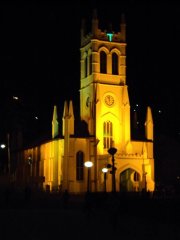
Shimla 
Shimla 
Rishikesh 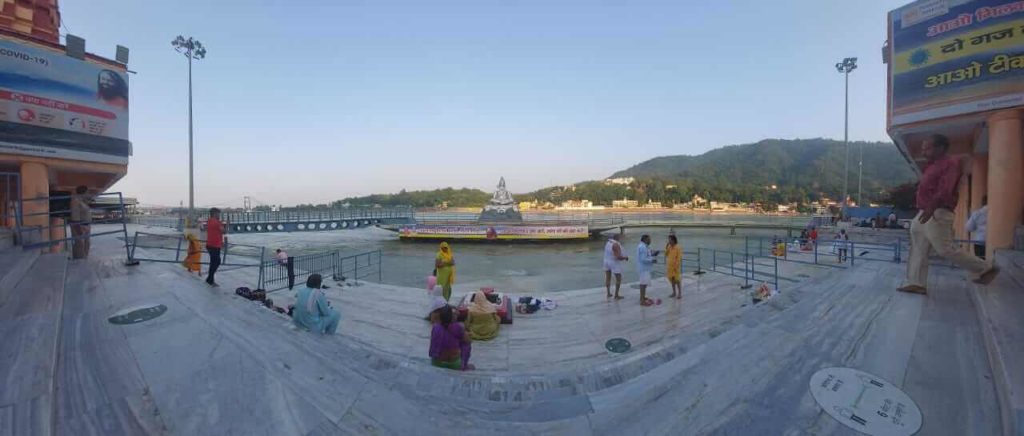
Rishikesh 
Lamkhaga Trek 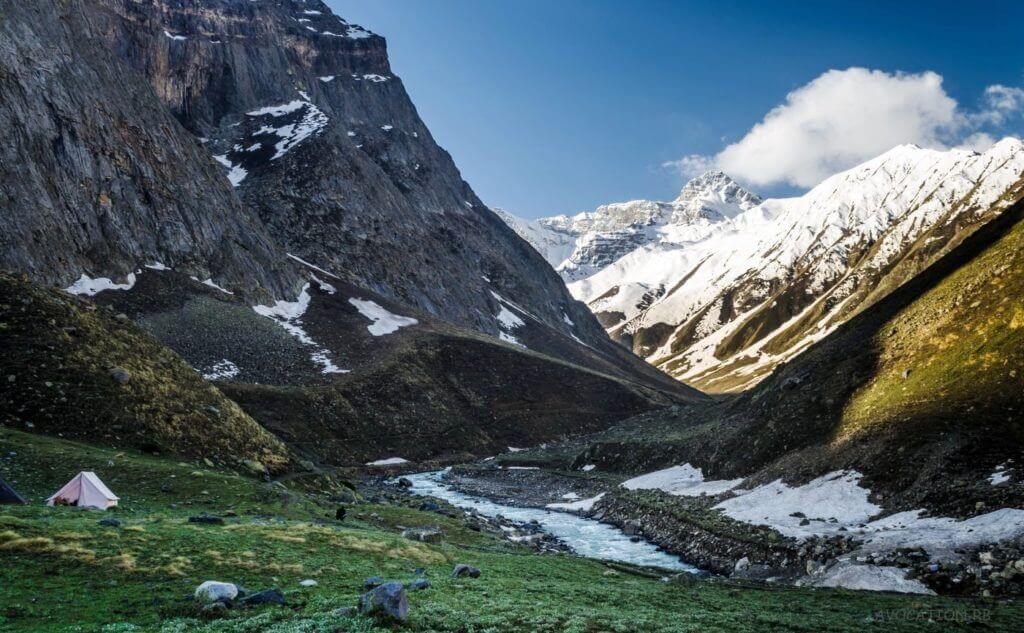
Lamkhaga Trek 
Lamkhaga Trek 
Lamkhaga Trek 
Lamkhaga Trek 
Lamkhaga Trek 
Harshil 
Lamkhaga Trek 
Lamkhaga Trek 
Lamkhaga Trek 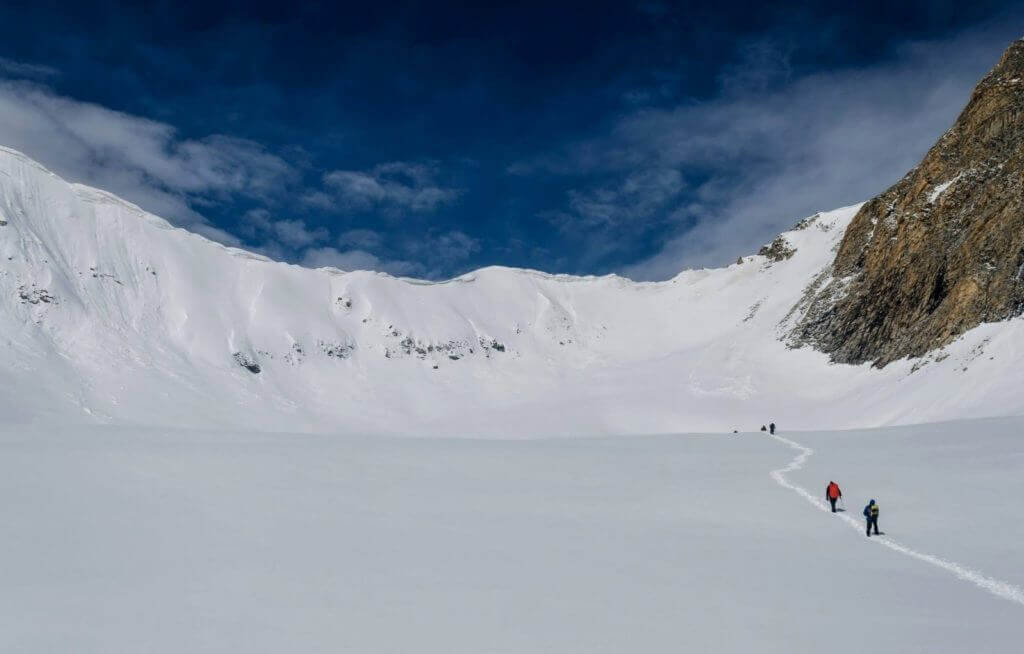
Lamkhaga Trek 
Chitkul
Prices and Dates
This tour can be done privately and in modified form at your favorite dates.
Best Time: Mai/June and September
Fixed date:
08.06.2025 -21.06.2025
1450 € per person
250 € Single charge supplement
Tour Info
Requirements
Though the difficulty level is an indefinite attribute, the following factors qualify Lamkhaga Pass for the most difficult trek in Himachal Pradesh.
- Near vertical incline from Lamkhaga snowfields to the pass summit.
- Long stretches of the glaciated route.
- Boulder-strewn zones
- More than 90km long trail
- Crossing high flowing ice-cold waters of Baspa river.
- high altitude
Information about the Trekking Tours with Chalo! Travels
Mountain guide and trekking team
On all our treks we have at least one (for larger groups of 6 participants two) trained local mountain guide. Our mountain guides have all completed at least the Indian mountaineering training, many of them have also completed the advanced courses.
They are familiar with the trekking routes and know the terrain excellently. All our mountain guides speak English.
In addition, there is a local team consisting of a cook (if the group consists of only two participants, the mountain guide also takes over the tasks of the cook), helpers, horsemen with horses or Nepalese porters, depending on the type of trek.
All our team members have been working with us for years, are very friendly and always strive to provide our guests with a great trekking experience. Their English (besides of the Guide) is rather mediocre or non-existent, but this is not necessarily a hindrance to communicating with them.
Trekking routes
The trekking routes are designed according the skills of our guests and are all feasible for a person with a good fitness level, unless otherwise mentioned. The daily routes are between five and eight hours long (with breaks) and an average increase of around 500-800 metres of altitude is completed.
In between, rivers may have to be crossed. The paths are partly well developed, but sometimes also almost non-existent. On our trekking routes there are hardly any villages in between, so we will take enough food for the whole tour.
On our treks we cross passes, snow or glaciers. On steep slopes, we have safety equipment with us.
Daily routine (Depending on the length and intensity of the trek, the times may vary)
7: 00 am Get up with Tea
7:30-8:30 am Breakfast
7:00-9:30 am Dismantling of the camp
8:00- 9:30 am Start Trek
1:00 pm Lunch on the way
3:00-5:00 pm Arrival at the camp and camp construction
3:30-5:30 pm Snacks
7:00 pm Dinner
Altitude and altitude sickness
Altitude sickness is a very important topic that should not be underestimated, especially during our trekking tours in the Indian Himalayas. At altitudes above 3500 m, our body has to slowly get used to the low air pressure, which also causes less oxygen to enter our lungs. The first signs of altitude sickness are headaches, which are accompanied by dizziness, nausea, insomnia and loss of appetite. It becomes problematic when water accumulates in the lungs and brain and edema occurs. Then only the immediate descent to lower altitudes will help. To prepare for the heights on our treks, we will either spend a few nights at high altitudes before the trek or slowly ascend during the trek to acclimatize. If we notice that there are problems with our guests (each person is otherwise able to acclimatize, regardless of age, gender and fitness level), it may happen that either the entire group or the concerned participant descends/returns with a team. In addition, it makes sense to take an emergency drug for altitude sickness. For this, it is best to consult the pharmacy or the travel doctor. For certain treks we will also have oxygen with us.
Luggage
Each trekking participant is responsible for his own clothes and personal belongings. Depending on the trek, we are either with horses or porters. If we have load horses, one bag per participant can be loaded onto the horse. In the case of treks with porters, all personal luggage must be carried independently. Tents, sleeping bags, mattresses and food are carried by our porters.
For trekking tours with horses, a day backpack with space for the lunchbox, a water bottle and warm overcoat clothing should be taken with you. Here to the complete packing list for our trekking tours.
Packing list for trekking tours
- sleeping bag at least -10°C (will be provided)
- large backpack or soft carrying bag so that the load animals can carry the luggage
- Small carrying backpack for the day approx. 30-40 l with rain protection
- flashlight/headlamp
- 2 refillable water bottles
- hiking poles
- passport and passport copy
- camera with spare battery and memory card
- headgear as sun protection
- Good Sunglasses
- cap
- Scarf, Buff
- Gloves
- wind-proof trekking pants
- trekking pants
- Functional Underwear Long
- hiking boots
- socks thick and thin
- sneakers, sandals and/or slats
- windbreaker
- Warm Jacket
- fleece sweater/jacket
- Tshirts
- sunscreen, lip balm min. Protection 40
- fat cream
- water purification tablets (boiled and filtered water is provided)
- own medications for headaches, nausea, digestive problems, colds)
- bubble patches and dressing material
- own hygiene articles
- Toilets Paper
- hand disinfection
Meals
During the trek there will be a vegetarian full catering. Water is either boiled or we have a water filter with us.
Accommodation and camp
We have very comfortable and spacious two-man tents. Our mattresses are practical but simple if there are problems with sleeping on hard surfaces, please take your own mattress with you or order from us. Our sleeping bags are freshly washed and have a very good quality with comfort zone up to -5°C/extreme zone up to -20° C. It is recommended to bring personal indoor sleeping bags.
In addition, we have a spacious dining tent with tables and chairs, a kitchen tent for the team and a toilet tent. For treks up to 4 people, the kitchen tent can also act as a dining tent at the same time.
For trekking tours with porters, we will take our smaller, lighter tents with us and do without a toilet tent.
Weather
In the Himalayas, temperatures fluctuate widely. While it can get warm up to 25°C during the day and the sun is not only warming, but also very intense (sun protection is a must), it can also cool down significantly below the minus-grade at night, especially in the months end of September and October, as well as in June. There may also be weather changes with snow on the passes.
